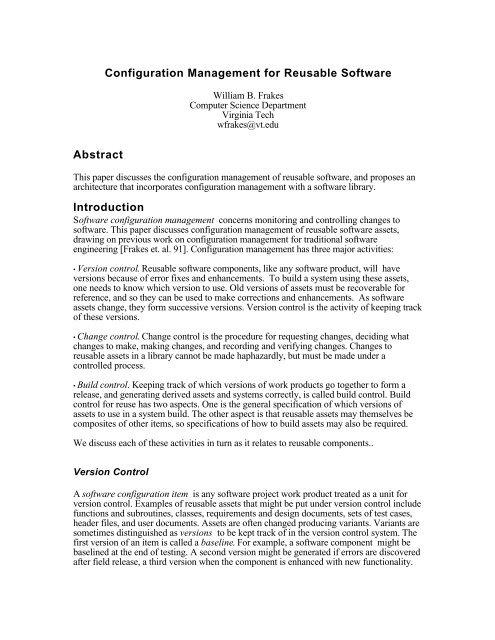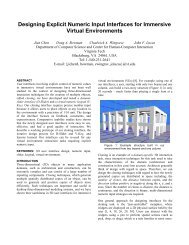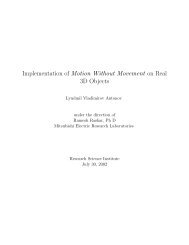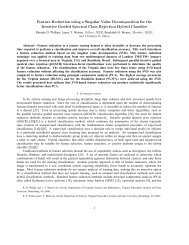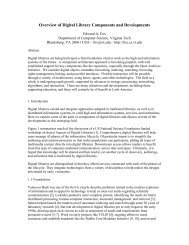Reuse Configuration Management - ResearchGate
Reuse Configuration Management - ResearchGate
Reuse Configuration Management - ResearchGate
Create successful ePaper yourself
Turn your PDF publications into a flip-book with our unique Google optimized e-Paper software.
<strong>Configuration</strong> <strong>Management</strong> for Reusable SoftwareWilliam B. FrakesComputer Science DepartmentVirginia Techwfrakes@vt.eduAbstractThis paper discusses the configuration management of reusable software, and proposes anarchitecture that incorporates configuration management with a software library.IntroductionSoftware configuration management concerns monitoring and controlling changes tosoftware. This paper discusses configuration management of reusable software assets,drawing on previous work on configuration management for traditional softwareengineering [Frakes et. al. 91]. <strong>Configuration</strong> management has three major activities:• Version control. Reusable software components, like any software product, will haveversions because of error fixes and enhancements. To build a system using these assets,one needs to know which version to use. Old versions of assets must be recoverable forreference, and so they can be used to make corrections and enhancements. As softwareassets change, they form successive versions. Version control is the activity of keeping trackof these versions.• Change control. Change control is the procedure for requesting changes, deciding whatchanges to make, making changes, and recording and verifying changes. Changes toreusable assets in a library cannot be made haphazardly, but must be made under acontrolled process.• Build control. Keeping track of which versions of work products go together to form arelease, and generating derived assets and systems correctly, is called build control. Buildcontrol for reuse has two aspects. One is the general specification of which versions ofassets to use in a system build. The other aspect is that reusable assets may themselves becomposites of other items, so specifications of how to build assets may also be required.We discuss each of these activities in turn as it relates to reusable components..Version ControlA software configuration item is any software project work product treated as a unit forversion control. Examples of reusable assets that might be put under version control includefunctions and subroutines, classes, requirements and design documents, sets of test cases,header files, and user documents. Assets are often changed producing variants. Variants aresometimes distinguished as versions to be kept track of in the version control system. Thefirst version of an item is called a baseline. For example, a software component might bebaselined at the end of testing. A second version might be generated if errors are discoveredafter field release, a third version when the component is enhanced with new functionality.
Except for baselines, versions are always created by changing previous versions, calledpredecessors. A version is a successor to its predecessor. There are two kinds of versions:.A version is a revision if it replaces another version. A version is a variation, or branch, if itis one of several alternative versions. Variations may be created from other versions, or maybe a baseline. Revisions are produced because it is constantly necessary to correct errors,remove or add information, and so forth. Variations are generated because of the need totailor components to different environments and users.To illustrate, suppose that a baseline component is changed to correct several mistakes. Thenew version is a revision of the baseline because it is meant to replace it. Two additionalcomponents might be generated from the corrected version describing two slightly differentcomponents for different operating systems. Because these three components arealternatives, with none meant to replace the others, they are variations, not revisions. In largeprojects generating multiple releases or multiple variations of releases for different operatingenvironments or markets, there may be many variations and revisions of all items. Versioncontrol systems must keep track of all versions of items, including successor andpredecessor information.The design of reusable assets involves the prediction of variant future uses, and reusableassets should be designed to make modifications as easy as possible. In theory, thechangeable parts of an asset should be hidden from a user; the visible interface should notchange or should change minimally when errors are corrected or enhancements made. Thus,the interface and implementation of an asset might be treated as distinct softwareconfiguration items.Version control is primarily record keeping, and a database tool is often used to support it.In a small ad-hoc reuse environment an informal system might do. Usually, however, thetask is large and complex, so mechanized tools like Source Code Control System (SCCS)[Rochkind, 75]and Revision Control System (RCS) [Tichy, 85] are required.Change ControlChange control is the activity of considering, deciding on, delegating responsibility for, andmonitoring changes to items. Change control is instituted as a collection of procedures,usually focused on a database system for documenting and tracking changes.Such a change tracking database system is called a change control system. Change controlmay be informal on small projects, perhaps using a logbook to document and track changes.On larger projects, strict change control procedures must be instituted along with amechanized system for documenting and tracking changes.The basic activities and processes of change control are the following: 1. Someone submitsa request for a change. Such requests are called MRs (modification requests), andsubmitting a request is called opening an MR. Usually a form, either paper or electronic,called a modification request form or MRF is used to open an MR. An example of an MRFfollows:Modification Request: Date of MR:APPLICATION: TYPE: SW RELEASE OCC:ORIG. NAME: EMAIL:DESCRIPTION:RELATED MRs:STATUS:
PRIOR STATUS:DUE DATE:TESTER:CATGORY CHNG:RESOLUTION SUMMARY:RESOLUTION:IMPACT:CHILDREN:MRs may be opened by customers, developers, managers, testers, documenters, or someselected subset of these groups. MRs may mention faults, errors, enhancements, typos, andso forth.If an MR is written against a requirement during the latter part of the life cycle, the changewill also possibly require changes in the design, code, test plans, and other later life-cycleproducts. The MRs written to change these later life-cycle products are said to be child MRsof the original MR. Another example of child MRs are changes in individual compilemodules dictated by a change in a common header file. Here, MRs to change the compilemodule are child MRs of the MR for the header. Reusable components will also be subjectto these concerns.2. MRs are reviewed by a change control authority or an MR review board that examineseach MR and decides on an appropriate action. The MR review board may be composed ofdevelopers, managers, testers, and so forth. In a typical development environment, the MRreview board will be project specific and may last only for the length of the project. In areuse situation, the authority of the MR review board may have to extend across projectsand organizations, and will have to last the lifetime of the reuse collection.Often the decision involves classifying the MRs according to their severity. A classificationsystem like the following is sometimes used:• Severity level 1. The item is unusable, incomprehensible, or unmanufacturable because of aproblem reported by the MR. For example, an MR reporting a software fault causing thesystem to crash during typical use would rate a severity rank of 1.• Severity level 2. The item is usable but unacceptable because of the problem reported in theMR. For example, a test case with partially incorrect input conditions might be given thisseverity classification.• Severity level 3. The item is usable, but the MR reports a failure to conform to standards,guidelines, or practices. For example, an MR reporting improperly formatted sectionheadings in a user document would receive a Level 3 severity ranking.• Severity level 4. The MR requests an enhancement or adaptation. For example, a requestfor a port to a personal computer would rank as a severity Level 4 MR.Once MRs are classified, the MR review board decides how to dispose of each MR. Amongthe possibilities accepting the MR and making the required change immediately, deferringthe MR, or rejecting the MR .3. Once a change is approved, a change tracking authority is notified and proceeds to trackthe progress of the change. SCCS provides crude support for build control of non-deriveditems in its version numbering system.4. The change must be planned, scheduled, assigned to a developer, implemented, reviewed,and verified. Once this is done, the change control authority is notified that the change iscompleted. The MR is closed, and the change becomes part of the next version of thesoftware configuration item. Change control systems can usually report the status of MRs,
generate statistics and reports summarizing the change activity of a project, and directnotifications and information about changes to people. Figure 2 illustrates the changecontrol process.ModificationTestSoftwareRequest (MR)OrganizationBuildMR Report OriginatorGroupMRMR ReportProjectPersonnelProject<strong>Management</strong>StatisticalAnalysisMRStatisticsMR ReportMRDataChange<strong>Management</strong>SystemBoardDecisionResponseMR ReportBug-fixResolutionPotentiallyAffectedMRReviewProcessOrganizationResponsiblePersonImpactAssessmentFormal change control systems introduce significant management overhead in developmentand maintenance. Consequently software configuration items are usually placed underchange control at the same time they are placed under version control, usually as late in thelife cycle as possible.Build ControlA software configuration is a set of item versions. Build control is the activity ofspecifying, tracking, and forming software configurations. Build control centers around thedatabase activity of maintaining complete specifications of software configurations as itemschange thorough the life cycle.An important group of items that are part of software configurations are derived items,items generated from other items, usually by the computer. Examples of derived itemsinclude object modules, executable files, test data, and so forth. Non-derived item buildcontrol is not difficult until there is more than one release of a system; then it can become adifficult problem. Non-derived item build control is usually done by hand. Efficient deriveditem build control is a difficult problem, but it yields to mechanization; many tools forderived item build control exist. For example, the primary build control tool in the UNIXenvironment is make, which automates the generation of derived items.Besides the primary activities of configuration management, configuration managementtools can produce data to help with project tracking. For instance, SCCS and RCS canreport how many lines have changed in project files. Since these changes, or deltas, are
easier to obtain than corrected error data, they are sometimes used as proxy metrics toestimate fault densities. Such data can be useful as an indicator of component quality.Software <strong>Reuse</strong> LibrariesA reuse library consists of a repository for storing reusable assets, a search interface thatallows users to search for assets in the repository, a representation method for the assetsand facilities for change management and quality assessment. Surveys of reuse librariesmay be found in [Frakes&Gandel 90] and [Milli et. al. 98].existing systemsUserselectClassifytransformcertifyRepositorysearchsystemdesignpurchaseSoftware LibraryThe figure above shows the major features of a reuse library. Reusable assets for thelibrary can be obtained through the re-engineering of parts in existing systems through aprocess of selection and transformation or they may be designed from scratch or purchased.However obtained, the assets will need to go through a certification process to assure thatthey meet the quality standards required by the library. Studies have shown that if usersbelieve that the library contains substandard components they will avoid using it [Carle 87].As shown in table 1, a distinction is often drawn between different levels of publishedliterature and this distinction applies to software assets as well as traditional printed mediasuch as books and papers. The primary reuse literature consists of the assets themselves,for example, code modules. The secondary literature consists of indexes which guide apotential user to the primary literature. The tertiary literature provides an index to assetindexes and so on. The process of developing good secondary and tertiary indexes forreusable software is ongoing. One important development has been the identification of alink between indexing and domain analysis [Frakes et. al. 98].Literature Level Book Asset ExamplePrimary book asset code moduleSecondary index to books index to assets index of code
Tertiaryindex to index tobooksTable 1: Levels of Indexingindex to index toassetsmodulesindex of indexes ofcode modulesThe next step is to classify, or assign a representation, to the assets. Good representationsare needed to help users find and understand assets in the library. Once classified theassets are stored in the repository. Users will then submit queries to the repository via asearch system. Topics that will need to be considered when creating an reuse libraryinclude:• the platforms used to implement the library storage mechanism• representation methods for the assets• search interfaces• version control• inter-operability of reuse libraries• the measurement and evaluation of reuse librariesIntegrated ArchitectureThe figure below shows a high level proposed architecture for a reuse environment thatintegrates a reuse library tool with tools for version control, change control, and buildcontrol. The ovals indicate needed activities, and the boxes available tools forimplementation. A system based on this architecture would provide an environment thatwould support both reuse and traditional software development activities.
An integrated architecture for configuration management ofreusable componentsProcessDatabaseRCSChangeControlMakeBuildComtrolVersionControl<strong>Configuration</strong>ManagemntSearchEngineDatabaseSummary<strong>Configuration</strong> management is an important part of software engineering. It includes threeinter-related activities: version control, change control, and build control. Existing softwaredevelopment environments, such as UNIX, offer tools to support these activities separately,This paper has discussed configuration management issues on terms of reusablecomponents, and has proposed an integrated architecture for combining tool support forconfiguration management and reuse libraries.REFERENCESCarle, R. (1987). Reusable Software Components for Missile Applications. In TenthMinnowbrook Workshop on Software <strong>Reuse</strong>, . Blue Mountain Lake, NY:Frakes, W. B., & Gandel, P. B. (1990). Representing Reusable Software. Information andSoftware Technology, 32(10), 653-664.
Frakes, W. B., Fox, C. J., & Nejmeh, B. A. (1991). Software Engineering in the UNIX/CEnvironment. Englewood Cliffs, NJ: Prentice-Hall.Frakes, W., Prieto-Diaz, R., & Fox, C. (1998). DARE: Domain Analysis and <strong>Reuse</strong>Environment. Annals of Software Engineering, 5, 125-151.Mili, A., Mili, R., & Mittermeir, R. T. (1998). A Survey of Software <strong>Reuse</strong> Libraries.Annals of Software Engineering, 5, 349-414.Rochkind, M. J., 1975 "The Source Code Control System," IEEE Transactions onSoftware Engineering, SE-1, no. 4 , 255-265.Tichy, W., "RCS—A System for Version Control," 1985 Software Practice andExperience, 15, no. 7 , 637-654.


